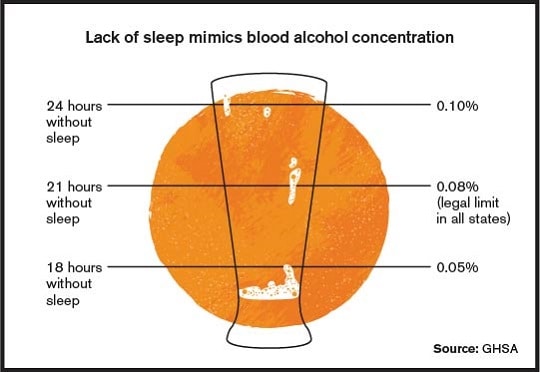You’d never consider getting behind the wheel while under the influence of drugs or alcohol. But you may, unknowingly, do something equally dangerous. You might even do it on a regular basis.
Researchers estimate that going 17-18 hours without sleep mimics a blood alcohol concentration of 0.05%. Pulled an all-nighter to finish a work project, stay up with a sick kid, or binge watch your favorite new show? At 24 hours without sleep, your body is acting at the equivalent of a 0.10% blood alcohol concentration (Dawson & Reid, 1997; Arnedt et al., 2001). You’re well over the legal limit, and there’s no breathalyzer or blood test to screen for your risky behavior. Drowsy driving is impaired driving.
A drowsy driver increases the risk of a crash or near-crash by four to six times when compared with an alert driver (Klauer et al., 2006).
What Makes Drowsy Driving so Dangerous?
If you came to Car Seats for the Littles looking for advice about how to safely transport children, we’ll go ahead and take a wild guess that you’re tired. More than one third of adults in the U.S. report typically sleeping less than the recommended seven-hour minimum (Liu et al., 2016). Many parents and caregivers are all too familiar with interrupted sleep, late nights, and early mornings. We’d even settle for a nap, but that doesn’t happen nearly often enough.
You might be so tired that you can’t recognize how tired you really are, even if it feels like you’ve gotten a second wind. We can’t be the only parents who have fallen asleep in a child’s room while waiting for them to drift off, only to wake up hours later, right? If you haven’t gotten enough sleep, your brain is tired, whether or not you feel sleepy.
Sleep may seem like a negotiable with your busy schedule, but it’s a non-negotiable for your body. Despite your best intentions to stay awake, your brain will opportunistically snag whatever rest it can. This phenomenon, called microsleep, means that your brain can fall asleep for periods as brief as a few seconds. You may not even realize it has happened unless your head bobs or you veer into the adjacent lane. Five seconds of microsleep on the interstate? You’ve traveled more than a football field while your brain is fast asleep.
Even if you do manage to stay awake while driving drowsy, your brain isn’t acting optimally. Your reaction times are slower than usual. Your judgment is impaired, sometimes causing you to take risks that you wouldn’t consider when well-rested. When you’re tired, your situational awareness suffers. (Any adult who has found themself mindlessly watching a kids’ show long after their kids have fallen asleep can attest to that.)
Driving is a task that requires full attention. Seconds, or even milliseconds, can make the difference between a collision and a near miss. Your drowsy brain is too sluggish to keep up with the demands of driving safely.
On the Road
If you ask your friends and family for their road trip tips, you may hear advice for handling the fatigue of a long drive. Fuel up on caffeine. Stock up on snacks. Crank up the music. Roll the windows down, or point the air conditioning vent at your face. Do these well-meaning ideas substitute for getting enough sleep? The answer is a resounding, “NO!”
Ways to Stay Awake
What can you do to help your brain stay awake while you’re driving?
- The most important step you can take to prevent drowsy driving comes as no surprise: SLEEP! This means getting enough sleep not only the night before a long drive but also in the nights leading up to it. Your body can’t overcome a major sleep deficit with just one night of recommended sleep. If it’s in the cards to take a short nap before leaving on a long trip, do it. (We won’t pretend we aren’t envious.) Again, there are no shortcuts to circumvent your body’s need for sleep.
- Stop regularly. Plan to take breaks every couple of hours to stretch your legs and give your brain a rest from the intense focus of driving. A brief stop to take a restroom break, eat some food, or get gas can leave your brain feeling refreshed. You might even discover some fun sights along your route. If you show symptoms of drowsy driving (frequent yawning, difficulty keeping your head up or eyes open, difficulty maintaining speed, drifting out of your lane, etc.), immediately find a safe place to park, whether or not you had planned to stop.
- Use the buddy system, where possible. Traveling with another adult in the passenger seat gives you two sets of eyes and ears to pay attention to the road. It means you’ll have someone else to adjust the temperature, change the music, and arbitrate disputes in the back seat (just us?). It also gives you the opportunity to switch drivers at each stop, allowing your brain to rest from the demands of driving.
- Avoid driving during times you know you’ll be drowsy. A cat nap or a cup of coffee can’t overcome your body’s natural circadian rhythms. Your brain has an internal clock that alternates between intervals of sleepiness and alertness. For most adults, these intervals of sleepiness occur in the middle of the night and then again in the mid-afternoon. Driving during your brain’s sleepy intervals is a recipe for drowsy driving, so plan your stops to avoid being on the road during those times.
Night Driving
Who wouldn’t want to travel during a time when the kids aren’t crying, fighting, or asking, “Are we there yet?” We frequently field questions in our Facebook group about making long drives overnight, while children are asleep.
Although we can definitely empathize with the appeal of silence, driving overnight is an approach that we wouldn’t generally recommend.
First and foremost, drowsy driving is a major concern. Even if you’re well-rested, your body still naturally experiences those intervals of sleepiness in the middle of the night.
Unless your circadian rhythms have fully shifted to nighttime wakefulness (usually only after a period of extended shift work), driving through the night automatically means drowsy driving.
Secondly, driving in darkness can pose issues with night vision; headlights and street lights simply can’t allow for the same range of vision you’d have with daytime driving. The glare from these lights can also be problematic for drivers who wear glasses. (Anti-reflective lens coatings may help to reduce this effect.) With less time to react to road hazards because of the limited field of vision, collisions are more likely.
Finally, nighttime travel is inherently risky. While you can ensure that you are well-rested and not under the influence of drugs or alcohol, you can’t make the same guarantee of other drivers on the road. Nearly half of passenger vehicle occupant fatalities happen during hours of darkness. This fatality rate per vehicle mile at nighttime is roughly triple the fatality rate of daytime driving (Varghese & Shankar, 2007).
A few (okay, maybe a few dozen) choruses of “are we there yet?” are a small price to pay for safer travel.
Only YOU Can Prevent Drowsy Driving
Fatigue-related crashes are a major problem. An estimated 21% of fatal crashes involved a drowsy driver (Tefft, 2014). Government organizations and vehicle manufacturers are working to promote safety measures like rumble strips and lane departure warning systems, but these measures can never fully compensate for driver choices. Keeping your littles as safe as possible means doing your best to avoid a crash in the first place. Drowsy driving is unsafe driving.
A worthy excuse to make space for more zzzs in your busy schedule? We’re all for it.
References
Arnedt, T., Wilde, G., Munt, P., & MacLean, A. (2001). How do prolonged wakefulness and alcohol compare in the decrements they produce on a simulated driving task? Accident Analysis & Prevention, 33, 337-344. https://doi.org/10.1016/S0001-4575(00)00047-6
Dawson, D., & Reid, K. (1997). Fatigue, alcohol and performance impairment. Nature, 388, 235. https://doi.org/10.1038/40775
Klauer, S.G., Dingus, T. A., Neale, V. L., Sudweeks, J.D., & Ramsey, D.J. (2006). The impact of driver inattention on near-crash/crash risk: An analysis using the 100-car naturalistic driving study data (DOT HS 810 594). National Highway Traffic Safety Administration. https://www.nhtsa.gov/DOT/NHTSA/NRD/Articles/HF/Reducing%20Unsafe%20behaviors/810594/810594.htm
Liu, Y., Wheaton, A.G., Chapman, D.P., Cunningham, T.J., Lu, H., & Croft, J.B. (2016). Prevalence of healthy sleep duration among adults — United States, 2014. Morbidity and Mortality Weekly Report, 65, 137–141. http://dx.doi.org/10.15585/mmwr.mm6506a1
Tefft, B.C. (2014). Prevalence of motor vehicle crashes involving drowsy drivers, United States, 2009-2013. AAA Foundation for Traffic Safety. https://aaafoundation.org/wp-content/uploads/2017/12/PrevalenceofMVCDrowsyDriversReport.pdf
Varghese, C., & Shankar, U. (2007). Passenger vehicle occupant fatalities by day and night – A contrast (DOT HS 810 637). National Highway Traffic Safety Administration. https://crashstats.nhtsa.dot.gov/Api/Public/ViewPublication/810637







